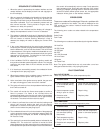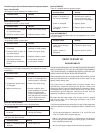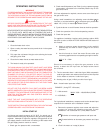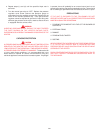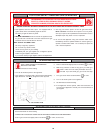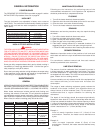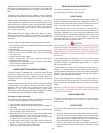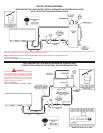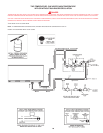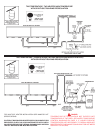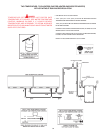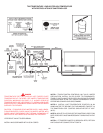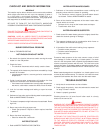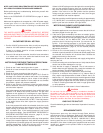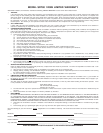
33
CHECKLIST AND SERVICE INFORMATION
IMPORTANT
The installer may be able to observe and correct certain problems
which might arise when the unit is put into operation or when it
is re-fired after a prolonged shutdown. HOWEVER, it is
recommended that only qualified servicemen, using appropriate
test equipment, be allowed to service the heater.
BE SURE TO TURN OFF THE ELECTRICITY WHENEVER
POSSIBLE OR APPROPRIATE WHILE CHECKING EQUIPMENT.
WARNING
FAILURE TO FOLLOW THESE INSTRUCTIONS CAN RESULT IN
SERIOUS PERSONAL INJURY OR DEATH.
CAUTION: LABEL ALL WIRES PRIOR TO DISCONNECTION
WHEN SERVICING CONTROLS. WIRING ERRORS CAN CAUSE
IMPROPER AND DANGEROUS OPERATION.
VERIFY PROPER OPERATION AFTER SERVICING.
BURNER OPERATIONAL PROBLEMS
1. Refer to TROUBLESHOOTING.
NOT ENOUGH OR NO HOT WATER
1. Be certain the electrical disconnect switch serving the water
heater is in the ON position.
2. Check the fuses.
• The electrical disconnect switch usually contains fuses.
3. The capacity of the heater may have been exceeded by a large
demand for hot water.
• Large demands require a recovery period to restore water
temperature.
4. Colder incoming water temperature will lengthen the time
required to heat water to the desired temperature.
• If the heater was installed when incoming water temperature
was warm, colder water creates the effect of less hot water.
5. Look for hot water wastage and leaking or open hot water
faucets.
6. Sediment or lime scale may be affecting water heater operation.
Refer to MAINTENANCE for details.
7. The heater’s temperature high limit sensor has activated. Reset
high limit.
8. Burner may not be firing at proper rate.
• Check gas pressure. Adjust to obtain required manifold
pressure.
9. Burner fan wheel may be dirty.
• Clean fan wheel with a stiff brush.
WATER IS TOO HOT
1. Refer to WATER TEMPERATURE CONTROL.
WATER HEATER MAKES SOUNDS
1. Sediment or lime scale accumulations cause rumbling and
pounding noises when the heater is operating.
• The sounds are normal, however, the tank bottom should
be cleaned. Refer to MAINTENANCE for details.
2. Some of the electrical components of the water heater make
sounds which are normal.
• Contacts click or snap as the heater starts and stops.
• Transformers often hum.
WATER LEAKAGE IS SUSPECTED
1. Check to see if the water heater gate valve is tightly closed. Also
check the cleanout opening for leakage.
2. The apparent leakage may be condensation which forms on
cool surfaces of the heater and piping.
3. If the outlet of the relief valve is leaking it may represent:
• Excessive water pressure.
• Excessive water temperature.
• Faulty relief valve.
Excessive water pressure is the most common cause of relief
valve leakage. It is often caused by a “closed system”. If a check
valve is in the inlet system it will not permit the expanded hot water
volume to equalize pressure with the main. The relief valve must
release this water or the water heater or plumbing system will be
damaged. Refer to MAINTENANCE-RELIEF VALVE section in this
manual.
Water heater damage due to installation in a closed system is not
covered by the limited warranty. The solution is to install a thermal
expansion tank between the check valve and the water heater.
TROUBLE-SHOOTING
1. Verify that all vent terminals are free of debris.
2. Check supply wire polarity - hot to hot and neutral to neutral and
no "stray" current in neutral.
3. Heater is properly grounded.
Checking these four (4) items first will often result in a timely
solution to the service call.
WARNING
JUMPING OUT COMPONENTS AND/OR CIRCUITS DURING
TROUBLESHOOTING CAN CAUSE SERIOUS PROBLEMS WITH
THE UNIT’S OPERATING SEQUENCE AND IGNITION SAFETY. IF
YOU DO NOT HAVE THE PROPER TEST EQUIPMENT, I.E. A VOLT-
OHM METER AND A MICROAMMETER, DO NOT ATTEMPT TO
TROUBLESHOOT OR REPAIR.
ALTERING THE CONTROLLER AND/OR CONTROLLER
WIRING IN ANY WAY COULD RESULT IN INTERNAL DAMAGE
TO THE MODULE CIRCUITS, POSSIBLY ALTERING THE
IGNITION SEQUENCE ALLOWING GAS VALVES TO OPEN
BEFORE THE HOT SURFACE IGNITER IS UP TO IGNITION
TEMPERATURE.



